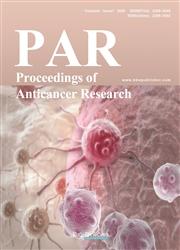Effects of IL-6/JAK2/STAT3 on the Biological Behavior of Oral Squamous Cell Carcinoma
引用次数: 0
Abstract
Objective: To investigate the effect of interleukin 6/Janus kinase 2/signal transducer and activator of transcription 3 (IL-6/JAK2/STAT3) on the biological behavior of oral squamous cell carcinoma (OSCC). Methods: OSCC cells were transfected with the designed lentiviral vector plasmid pGMLV-SB3 (experimental group) and the corresponding negative control plasmid pGMLV-SB3-shNC (control group); 48 hours after transfection, a liposome transfection kit (Sigma, USA) was used for lentivirus packaging; after virus packaging, a medium containing pGMLV-SB3 lentiviral vector was added and cultured for 24 h; the cells were harvested, and RNA was extracted; Transwell chamber assay (Sigma, USA) was used to detect cell migration and invasion ability; dot-enzyme-linked immunosorbent assay (ELISA) kit was used to detect the level of interleukin 6 (IL-6) in the culture supernatant, while serum IL-6 level was measured by ELISA. Results: The expressions of IL-6, JAK2, and STAT3 in the experimental group were significantly raised, as compared to the control group (P < 0.05); the apoptosis rate of OSCC cells in the experimental group, which was detected by flow cytometry 48 h after transfection, was significantly higher than that of cells in the control group (P < 0.05); and there was a significant improvement in the experimental group’s cell migration and invasion ability, as compared to that of the control group (P < 0.05). Conclusion: The IL-6/JAK2/STAT3 signaling pathway plays an important role in the migration and invasion of OSCC cells. Inhibiting the expression of IL-6 can inhibit the growth and proliferation of OSCC cells as well as reduce their ability to invade and migrate. These results provide a new target for the treatment of OSCC.IL-6/JAK2/STAT3对口腔鳞状细胞癌生物学行为的影响
目的:探讨白细胞介素6/Janus激酶2/信号转导子和转录激活子3(IL-6/JAK2/STAT3)对口腔鳞状细胞癌(OSCC)生物学行为的影响。方法:用设计的慢病毒载体pGMLV-SB3(实验组)和相应的阴性对照质粒pGMLV-SB3-shNC(对照组)转染OSCC细胞;转染48小时后,脂质体转染试剂盒(Sigma,USA)用于慢病毒包装;病毒包装后,加入含有pGMLV-SB3慢病毒载体的培养基并培养24小时;收获细胞并提取RNA;Transwell室测定法(Sigma,USA)用于检测细胞迁移和侵袭能力;用斑点酶联免疫吸附试验(ELISA)试剂盒检测培养上清液中白细胞介素6(IL-6)水平,用ELISA法测定血清IL-6水平。结果:与对照组相比,实验组IL-6、JAK2和STAT3的表达显著升高(P<0.05);流式细胞仪检测转染后48h实验组OSCC细胞凋亡率明显高于对照组(P<0.05);结论:IL-6/JAK2/STAT3信号通路在OSCC细胞的迁移和侵袭中起重要作用。抑制IL-6的表达可以抑制OSCC细胞的生长和增殖,并降低其入侵和迁移的能力。这些结果为OSCC的治疗提供了一个新的靶点。
本文章由计算机程序翻译,如有差异,请以英文原文为准。
求助全文
约1分钟内获得全文
求助全文

 求助内容:
求助内容: 应助结果提醒方式:
应助结果提醒方式:


